7th January 1963
The Barron Knights
14th January 1963
TONY BOLTON & THE FEDERALS
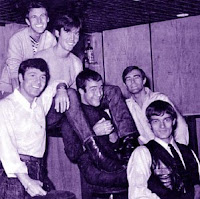
From Watford and born out of long forgotten band The Beatniks, Bolton & The Feds were another group who recorded for Parlophone Records with their debut single “Brazil”, released during this very month. Despite employing the talents of Mr Bolton on vocals, it would appear that a lot of their output was Tornado-inspired instrumentals which suggests they had one of those contracts that allowed them to release material under both camps. Not that it mattered that much as chart action was non-existent either way. Other Parlophone 45’s followed, including a cover version of The Platters “Twilight Time” and their final release, 1965’s “Bucket Full Of Love” but they never threatened to trouble the charts with their particular brand of beat music. As the mid-60’s beckoned, The Top Twenty effectively became a nursery for a number of musicians who later found fame and fortune elsewhere, a situation that was no doubt being repeated in venues the length and breadth of the country. Hiding within The Federals line-up was keyboard player Tony Kaye (real name Tony Selvidge.) He was a member of several bands during the 60’s, amongst them Johnny Taylor’s Star Combo and Jimmy Winston & His Reflections but later became an original member of Yes and appeared on their breakthrough album “The Yes Album” in 1970. Incidentally, Tony Bolton & The Federals were one of those bands labelled under the “Comedy/Vocal/Instrumental” umbrella and even though one cannot imagine Bolton augmenting his vocal performance with a stand-up routine, apparently the description turns out to be true as, according to a Top 20 blog contributor, one of the band who also played the trumpet used to lark about on stage quite a lot. Intriguingly there is also a grainy Pathe News film snippet that has appeared on YouTube featuring Bolton with Helen Shapiro. This apparently dates from 1968 and was filmed in, of all places, Romania. Which means that Bolton was probably one of the first British male singers to perform behind the iron curtain. The Romanian connection is cemented still further by an appearance of an album by the band released in that country in 1965. The album, featuring cover versions of well known pop songs, was undoubtedly intended as an attempt to give the culturally-starved eastern Europeans some good old British rock n’roll.
28th January 1963
Dale Rivers & The Ramrods
Friday Night Jive concerts for January at The Blake Hall were; 5th Teddy Valour & The Valiants 12th The Raiders with Rod Young – 19th Mike Slain & The Vikings – 26th Tony & His Fabulous Tycoons. There was also a “Friday Jive” night at The Town Hall on the 11th January featuring “The West of England Jive Group” Nick & The Senators and a “Special Jive Night” on Monday 21st January at The Blake Hall with The Tornados (from Blandford) Altogether a very busy month!
4th February 1963
PETER JAY & THE JAYWALKERS
A band that straddled the period between early 60’s British pop and the oncoming rush of Merseybeat, Jay & The Jaywalkers played the Town Hall 4 times, though three of those appearances occurred in 1963. They were primarily an instrumental band based around both Peter Jay’s percussive perspicacity and a raucous brass section, though they also boasted no less than 4 guitar players, according to publicity photographs. 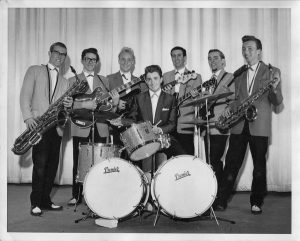 They achieved a No.31 hit in October 1962 with their debut single, the Joe Meek produced “Can Can 62”, a track that became a staple diet of Jaywalkers gigs for some time afterwards. Despite the obvious novelty factor of this record and the slightly ludicrous spectacle of the group performing the routine during their live shows, they were apparently a more than competent combo, and toured the UK with The Beatles during the same year as their Top Twenty debut. Early singles included the Meek creations “Totem Pole” and “Poet & Peasant”, the latter of which appeared in May 1963 and it wasn’t until October’s “Kansas City” that they released the first single to feature vocals. There were a lot of instrumental bands in the early 60’s and at least initially, most were 4-piece guitar groups, all of which paid a heavy debt to The Shadows. By the time the Jaywalkers had made their Town Hall debut, they were in the process of becoming a little “old hat” and with a new emphasis on writing ones own material, they were swiftly becoming a dying breed. Survival depended on how adaptable they were – they could either be used as a backing band for other artists or could rely on a steady stream of live bookings that centred around a dynamic stage act. The Jaywalkers relied on the latter for awhile but after guitarist Peter Miller left in 1966 to concentrate on songwriting, they began to flounder and were in need of some fresh blood. During their latter years, they became a quartet, calling themselves, with stunning originality, Peter Jay & The New Jaywalkers and turning their attention to soul music. One significant new recruit during this period was Terry Reid, a “nearly made it” man who holds the dubious distinction of once turning down the opportunity to join Led Zeppelin. Reid joined the band in 1966/67 just prior to their eventual split but despite Jay’s retained involvement, their final single, 1967’s excellent “The Hand Don’t Fit The Glove” was credited to Terry Reid & The Jaywalkers. An impressive support slot on a Rolling Stones UK tour followed but was not enough to save them from extinction.
They achieved a No.31 hit in October 1962 with their debut single, the Joe Meek produced “Can Can 62”, a track that became a staple diet of Jaywalkers gigs for some time afterwards. Despite the obvious novelty factor of this record and the slightly ludicrous spectacle of the group performing the routine during their live shows, they were apparently a more than competent combo, and toured the UK with The Beatles during the same year as their Top Twenty debut. Early singles included the Meek creations “Totem Pole” and “Poet & Peasant”, the latter of which appeared in May 1963 and it wasn’t until October’s “Kansas City” that they released the first single to feature vocals. There were a lot of instrumental bands in the early 60’s and at least initially, most were 4-piece guitar groups, all of which paid a heavy debt to The Shadows. By the time the Jaywalkers had made their Town Hall debut, they were in the process of becoming a little “old hat” and with a new emphasis on writing ones own material, they were swiftly becoming a dying breed. Survival depended on how adaptable they were – they could either be used as a backing band for other artists or could rely on a steady stream of live bookings that centred around a dynamic stage act. The Jaywalkers relied on the latter for awhile but after guitarist Peter Miller left in 1966 to concentrate on songwriting, they began to flounder and were in need of some fresh blood. During their latter years, they became a quartet, calling themselves, with stunning originality, Peter Jay & The New Jaywalkers and turning their attention to soul music. One significant new recruit during this period was Terry Reid, a “nearly made it” man who holds the dubious distinction of once turning down the opportunity to join Led Zeppelin. Reid joined the band in 1966/67 just prior to their eventual split but despite Jay’s retained involvement, their final single, 1967’s excellent “The Hand Don’t Fit The Glove” was credited to Terry Reid & The Jaywalkers. An impressive support slot on a Rolling Stones UK tour followed but was not enough to save them from extinction.
In the 5th February 1963 edition of the Bridgwater Mercury, the weekly ad for the Top Twenty sensationally mentions “Another New Up and Coming Group – Electric Organ, Sax, Guitars, Drums” The group in question? The terribly obscure The Tartans (see below) Of far more interest was the advertisement that appeared directly above…….
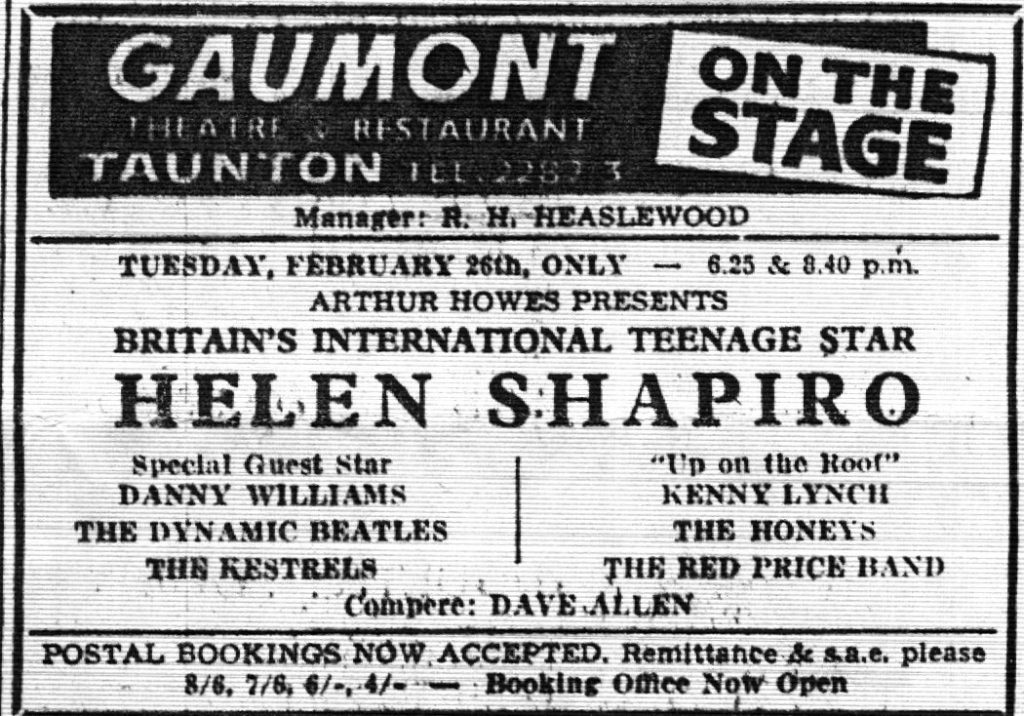
The “Dynamic” Beatles were only 4th on the bill for the 26th February concert but it wasn’t long before everyone in the UK knew exactly who they were.
By some strange coincidence, appearing at The Bridgwater Arts Centre on the very evening that this advert appeared was The Alan Civil Horn Trio. What’s that you say? Never heard of him? Alan Civil, for all you Non-Beatlephiles out there played the horn solo on Revolver’s “For No One” in 1966. Spooky or what? As a footnote to this advert, The Beatles were almost booked by Alford for The Top Twenty in 1962. Alford, still keeping one eye firmly on the charts, was apparently impressed by The Beatles debut single “Love Me Do” and contacted Brian Epstein with the idea of booking the band for the south west. Epstein was keen for his lads to be represented “down south” but wanted £1000.00 for the privilege – a ridiculous sum of money for a group that had only just started their career and with just one Top 20 single under their belt. Some haggling ensued, with Alford prepared to go to £500.00 but no higher. Epstein would not budge, consequently the booking never took place.
11th February 1963
THE TARTANS
Probably one of the most obscure bands to ever play The Top Twenty, I haven’t got the foggiest as to who The Tartans were but regarding their somewhat colloquial name, would suggest that they were not from “round these parts”. The only reference that I have found that fits chronologically, if not geographically, is from the web site Irish-Showbands.com. It mentions a band called The Tartans that were in existence during the 1960’s but sadly does not provide any further info. A genuine, possibly Celtic, curiosity.
18th February 1963
Johnny Carr & The Cadillacs
25th February 1963
THE DOWLANDS with The Soundtracks
From Bournemouth, David and Keith Dowland were yet another from the Everly Brothers imitator production line. With a backing group that included Roy Phillips (a Ray Charles look-alike who later joined 60’s band The Peddlers) and drummer Chris Warman, the duo were enormously successful locally. In 1962, their Joe Meek-produced debut single, “Little Sue”, was issued on Oriole. Later Meek recordings included “Big Big Fella”, “Break Ups” and a 1963 arrangement of Johnny Cash’s “I Walk The Line”, but it was only when Meek began to dip his toes into the Merseybeat sound that the group made chart headway. While “Wishin’ And Hopin'” and “Don’t Make Me Over’ were trumped by both the Merseybeats’ and the Swinging Blue Jeans’ respective versions, the brothers hastily released a Beatles cover of “All My Loving’ (which sounds like Lennon & McCartney on helium) and spent seven weeks in the UK Top 50 in early 1964. (The single was also released in the States on the Tollie label). They appeared on several British package tours on the strength of the record’s release but, via Meek’s emotional disintegration and long gaps between record releases, the Dowlands decline was inevitable. Though Keith Dowland quit the music business early doors, brother David continued working intermittently up until the mid-80’s.
February’s Blake Hall Roll Call; 2nd – Jimmy Treharne & The Pressmen – 9th The Mustangs – 16th Bob Fremton & The K.D.C. – 23rd Teddy Valour & The Valiants
4th March 1963
The Detours
11th March 1963
THE ORIGINAL CHECKMATES
This was the ashes of the band known as Emile Ford & The Checkmates, who scored a No.1 hit in 1959 with “What Do You Want To Make Those Eyes At Me For?”, a song originally written in 1917. Emile Sweetman was born in Castries, St.Lucia and arrived in the UK during the 1950’s seeking work as a sound engineer. Sometime after his arrival Ford formed The Checkmates with two of his half-brothers (George & Dave Sweetman) and won a talent contest sponsored by Pye Records. From the resulting audition, their first single, a Joe Meek-produced cover version of Don Gibson’s “Don’t Tell Me Your Troubles” was scheduled for release but Pye wisely chose the B-side and it went straight to the top of the charts. Ford & his Checkmates enjoyed a particularly fruitful 1960, securing 3 more Top 40 hits, 2 of which entered the Top 10, but their place in the sun was short-lived and by late 1962 the band had slowly been swallowed up by the new sounds that were emerging. Ford left, initially to concentrate on a solo career but he eventually gave up singing altogether in 1963 to return to his first love, studio engineering. His band continued, albeit in two separate factions, with his backing musicians forming The Excheckers and Ford’s Sweetman siblings becoming The Original Checkmates with the latter continuing to record with Joe Meek for Decca and Parlophone. Whilst with Meek, The Checkmates became just another band that the producer used in an attempt to repeat the success of “Telstar” with a series of releases that bore a striking resemblance to The Tornadoes hit. Checkmate releases included “You’ve Got To Have A Gimmick Today” (March 1963) described by one journalist as “breathtakingly appalling” and “an exercise in complete and utter bilge”, “Union Pacific” (June 1963) a Shadows/Tornadoes hybrid and an entire album’s worth of material released on the Pye label during the same year. The Checkmates were used frequently by Meek during the year of their Top Twenty appearance as backing musicians, particularly when his “other” band The Outlaws were unavailable and they apparently worked extensively with Michael Cox both on record and during the singer’s hugely successful tour of Scandinavia.
18th March 1963
“A Special Jive Night” “Tony & The Fabulous Tycoons” – Blake Hall
19th March 1963
TWIST TO “DISCS”
Two youngsters twisted their way to a guest appearance on the TWW pop show “Discs A Go-Go” at Saturday’s twist competition held at the Odeon Theatre, Bridgwater and organised by the manager Mr.John Tucker. The winners, Joyce Baker and Michael Wenmouth were among finalists who had been selected from six previous contests. They were chosen by a Bridgwater Mercury reporter, Michael Hughes who acted as judge. All the competitors were members of the Odeon Boys and Girls Club, which meets on Saturday mornings. Joyce and Michael will have tea with the compere of “Discs A Go-Go” Kent Walton and will be guests on the programme.
25th March 1963
NICK TROY & THE TROJANS
This wonderfully-named band were yet another from the Southampton area. They were formed by drummer Alan House with 4 of the 5 members having attended Hardly County Secondary School in Fawley. After originally being called both the Blueteens & The Phantoms, lead singer Graham Gay came up with their ludicrous alter ego and the name stuck. Looking at their short but interesting biography, 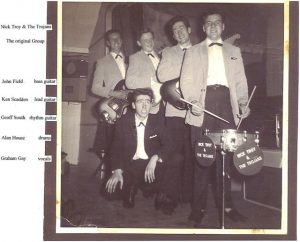 they appear to have been a band who had a knack of employing people with the most unlikely names including a bass guitarist called Godfrey Lightning and a female vocalist called Esme Duval. Having played the local area as one of Len Canham’s artists, they finished second on a local TV talent show called “Home Grown” in 1962, and during the following year hit the road, taking in Bridgwater en route. By this time they were being backed by the glamorous “Twistettes”, a female vocal/dancing duo, one of which was Esme White. When the other Twistette decided that life in the back of a Commer Van wasn’t quite what she expected, Esme changed her name and became the sole female vocalist. In 1964 the band finally turned professional and after the customary stint in Hamburg, they were offered a three-month contract playing American-forces bases in Frankfurt. They were a show band primarily, playing rock n’roll but also incorporating comedy and theatre tunes into their repertoire. Upon returning from Germany the band moved to London, Duval left to get married and the remaining band members made several attempts to find fame and fortune, recording a number of demo discs and completing an audition for EMI. But nothing came of it and the band eventually split up in 1968. The lure of rock n’roll is a strong one however, and the original five members of the band re-formed in 2004.
they appear to have been a band who had a knack of employing people with the most unlikely names including a bass guitarist called Godfrey Lightning and a female vocalist called Esme Duval. Having played the local area as one of Len Canham’s artists, they finished second on a local TV talent show called “Home Grown” in 1962, and during the following year hit the road, taking in Bridgwater en route. By this time they were being backed by the glamorous “Twistettes”, a female vocal/dancing duo, one of which was Esme White. When the other Twistette decided that life in the back of a Commer Van wasn’t quite what she expected, Esme changed her name and became the sole female vocalist. In 1964 the band finally turned professional and after the customary stint in Hamburg, they were offered a three-month contract playing American-forces bases in Frankfurt. They were a show band primarily, playing rock n’roll but also incorporating comedy and theatre tunes into their repertoire. Upon returning from Germany the band moved to London, Duval left to get married and the remaining band members made several attempts to find fame and fortune, recording a number of demo discs and completing an audition for EMI. But nothing came of it and the band eventually split up in 1968. The lure of rock n’roll is a strong one however, and the original five members of the band re-formed in 2004.
8th April 1963
JERRY WILLIAMS & THE VIOLENTS
Back in the pre-Abba days when World Music meant Elvis Presley singing in German it was somewhat rare to find a band treading the boards that were from any European country apart from the UK but Williams & his rather punkish-sounding Violents were from the same land that spawned Agnetha, Benny, Bjorn and Anna-Frid. There are several references to this band on the net but there does not appear to be a definitive history for a singer who has not only been performing for over 40 years but who appears to be regarded as a pioneer of Swedish popular music, influencing countless musicians along the way (that’s Swedish musicians obviously.) According to one less-than-informative biography, Williams was christened Erik Sven Fernstrom in 1942 in Solna, Stockholm and was born on his parents sofa – an insightful piece of information I’m sure you will agree. Williams started his career in 1957 and joined forces with the instrumental band The Violents sometime between 1960 & 1962 after the group had decided to augment their line-up with a vocalist. Sometimes known as Mr.Dynamite (a nickname stolen shamelessly from James Brown) Williams outgrew his original employers as his star rose with The Violents eventually becoming mere backing musicians to the enigmatic vocalist (or so the biography says). “When Jerry Williams gets going you can compare it to a box of dynamite going off. He jumps, struts, twists and exhausts himself completely. His hair flies, sweat pours. Nobody can stand still when he goes for it. Mods and Rockers, everybody likes Jerry” says Stora from Sweden. Thank you Stora! We do know that Williams & The Violents played the Star Club in Germany during the same period as the Fab Four and that Williams enjoyed 5 Top 10 hits in his native country during the 60’s but had to wait until 1969 before obtaining his first No.1. He appears to have had an extensive discography and apart from being a “rock n’roller” had his own “Jerry Williams Talk Show” on Swedish TV in 1968. He also appeared in the films “G – som i gemenskap” and “Lilla Jonssonligan och Cornflakeskuppen” (A film about a breakfast cereal?). One Swedish fan sums up the singer by offering the following crucial information. “When the Beatles hit Sweden in 1964 he refused to compromise. I gave no hits but he still could make his living playing. In 1965 Bildjournalen, the teenage paper wrote an biography comparing him to other Swedish rock kings. They had all been forced to go back to their normal jobs” That clears that up then. A trawl through a number of YouTube clips reveals a competent singer and band but with a unintentionally hilarious line in over the top terpsichory that makes it hard to take him seriously. The video below unfortunately concentrates as much on the audience as it does Williams’ gyrations but it least gives some idea of the man’s dynamism. I particularly like the fact that having been molested by two young women from the audience, no-one makes any attempt to get rid of them.
Jerry Williams & The Violents – Wear My Ring Around Your Neck (1963)
22nd April 1963
GARY LANDIS & THE REBELS
Yet another selection of complete unknowns, the only clue as to their identity coming from the Bridgwater Mercury’s ad which states that they were a “A Really Great Beat Group”. That would be a really great beat group that no-one has heard of then. Perhaps you simply had to be there.
23rd April 1963
“THEY TWISTED TO SUCCESS”
When Bridgwater teenagers Joyce Baker & Michael Wenmouth entered a twist competition at the Bridgwater Odeon, they did not know that it would lead to a V.I.P. visit to a television studio. Joyce of 137 Rhode Lane and Michael of 4 Coronation Road, won the competition and as a special prize were invited to the TWW Television Centre, Bath Road, Bristol, to appear in a special recording of TWW’s Top Ten programme “Discs A Go-Go”. For hours they twisted and jived during the rehearsals under the blazing studio lights and then “got with it” as the programme was recorded. Viewers saw the youngsters on the screen on Easter Monday. Highlight of the visit came at the end of the programme when Joyce and Michael were introduced to the disc jockey and compere of the programme, Kent Walton. A breezy chat with Kent and smiles as they posed for pictures on the studio set brought a thrilling end to the day for them.
29th April 1963
The Dowland Bros with the Soundtracks
There does not appear to have been any “Jive Nights” at the Blake Hall from April onwards, either that or they simply stopped advertising them. However, there was a grand “Modern Dance” at the Town Hall on the13th April with – Direct from London – The Dan Reilly Five (“featuring the Swinging Electric Organ with singing star Rita Lee”) Like, Dullsville.
6th May 1963
Peter Jay & The Jaywalkers
13th May 1963
JOHNNY MILTON & THE CONDORS
Milton and his band were from Essex and, like Jerry Williams’ Violents to a certain extent, were another group hijacked by their lead vocalist. The Condors were drummer Clive Graham’s band but as Milton had the best voice he became their front man. Not to be confused with “The Johnny Milton Band” who recorded the terribly obscure “Charleston Cocktail” for the Oriole label in 1961, they were managed by Geoff Stephens, a successful song-writer who had written both The Applejacks “Tell Me When” and Dave Berry’s “The Crying Game”. It’s a pity then that his songwriting skills failed to yield a hit for his own group as the sum total of their efforts were just 2 singles, “A Girl Named Sue” (Decca) and “Cry Baby” (Fontana) both in 1964, the latter of which was a cover version of the excellent Garnet Mimms original. They may look just like boys-next-door but these boys have something extra. It’s a little thing called star potential and a special feeling called rhythm. They have such a polished stage act, you can’t understand why they haven’t hit the big time yet. Their stage act has to be seen to be believed. So says an unknown music magazine from 1965. Sadly despite this enthusiastic but somewhat mis-informed piece of information by the end of that year the band had fractured with some of the musicians continuing under the name The Symbols. Incidentally The Bridgwater Mercury advert tantalising tells us that at the point of playing the Town Hall the group were currently appearing in a film called “Money Spins”. A film so obscure that even the All Movie Guide has never heard of it.
20th May 1963
Johnny Carr & The Cadillacs
27th May 1963
The Barron Knights
The Top Twenty closed for the months June, July and August 1963 and by now the winds of change were blowing through British popular music. By the time the Top Twenty had reconvened from it’s customary 3 month break, it was obvious that the music scene was no longer the sole property of Cliff Richard, Frank Ifield and a plethora of American singers called Bobby. Merseybeat had evolved from it’s skiffle origins and “Beat Groups” began taking over the British singles charts. With the Brian Epstein NEMS empire growing almost daily, The Beatles were at the forefront of this revolution. “Please Please Me” hit the music charts in February and in April 1963 Gerry & The Pacemakers had taken “How Do You Do It” to No.1. With television programmes like “Thank Your Lucky Stars” showcasing new bands to millions of TV viewers on a weekly basis, suddenly the emphasis was on Britain and not what was happening across the Atlantic. At this point The Top Twenty was well established and had been turning over a fairly healthy profit. It might have made sense to have stuck to this winning formula but from September onwards there was a noticeable shift away from the plethora of pretend-Presley’s that had graced the Town Hall stage previously. A few members of the old guard were retained but even though the Peter Jay’s, Johnny Carr’s and Bobby Angelo’s of this world could still command regular spots, artists like Danny Davis and Barrie James were now old hat. The Top Twenty kept moving with the times and a selection of new bands offering an exciting and vibrant alternative began to appear.
2nd September 1963
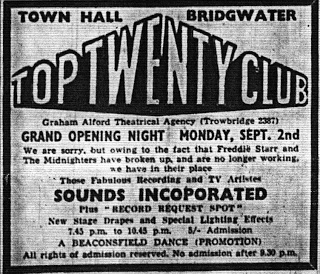
SOUNDS INCORPORATED
From Dartford, Kent and formed in 1961, Sounds Incorporated were an instrumental band that was not comprised of the conventional guitar/bass/drums instrumentation but centred around three saxophonists (Alan “Boots” Holmes, “Major” Griff West and Barrie Cameron.) After building a solid reputation in the Woolwich area they got their big break in August 1961 when Gene Vincent’s Blue Caps were prevented from entering the country due to union restrictions and Sounds Incorporated were used as his “scratch” band instead. (They even cut a record with Vincent in that very month entitled “I’m Going Home”) This not only led to securing a contract with Parlophone Records but also gave them a reputation as a more than dependable backing band that resulted in them being used by a number of travelling American stars such as Little Richard, Jerry Lee Lewis, Brenda Lee & Sam Cooke. However, despite their exemplary skills as musicians, the transition from concert stage to chart action proved difficult. Their one and only record for Parlophone – “Mogambo” – failed to make any waves and after moving to Decca, subsequent releases “Sounds Like Locomotion” (1962) “Stop” (the “B”-side of which was cheekily entitled “Go”) and “Order Of The Keys” (1963), also stubbornly refused to shift any significant units despite most of these singles featuring Joe Meek at the controls, a man who was seemingly responsible for 98% of ALL early 60’s British output but whose name on the credits didn’t always mean instant success anymore. It wasn’t until after their Town Hall appearance that things started to take off. A visit to Hamburg and The Star Club saw them rubbing shoulders with those lovable moptops and after being signed to the Epstein conglomerate they not only enjoyed a couple of minor hits on their third label Columbia but obtained a regular slot as Cilla Black’s backing band. In 1964, their rousing, over the top and hugely enjoyable rendition of the “William Tell Overture” may have been ignored in the UK but went to No.1 in Australia but ultimately their biggest achievement was opening for The Beatles in front of approximately 55,000 fans at the infamous Shea Stadium concert on the 15th August 1965. Despite being seriously hampered by the lack of a vocalist within their ranks, during a period when bands of their ilk were no longer as prolific or as popular as they had been, they easily held the position as the top instrumental band in the UK during the “beat” years. Featuring a very showy stage act that involved a great deal of athletic cavorting, one would imagine that this gig would have been a hugely enjoyable watch back in the day. They released a couple of albums for EMI, “Sounds Incorporated” in 1964 and “Studio Two” in 1966 but despite the first record featuring a decent version of West Side Story’s “Maria” that would have made a good single, attempts at showing off their talents as an all-round band, including a handful of tracks featuring vocals, only highlighted their limitations. A saxophone-led version of “Zorba The Greek”? Umm.. no thanks. They later changed their name to “Sounds Inc” whilst other feathers to their bow are that the aforementioned horn section made a brash guest appearance on Sgt.Pepper’s “Good Morning Good Morning” whilst drummer Tony Newman later joined The Jeff Beck Group and subsequently played with David Bowie on “Diamond Dogs” in 1974.
Sounds Incorporated – Keep Moving (released August 1963)
The advertisement reveals that Sounds Incorporated were a last-minute replacement for another band that had unfortunately disbanded prior to their Top Twenty engagement. A shame, as the cancellation spared us the opportunity to see Freddie “Ate My Hamster” Starr appearing with his band The Midnighters, just prior to his conversion to stand-up comedian and complete lunatic.
5th September 1963
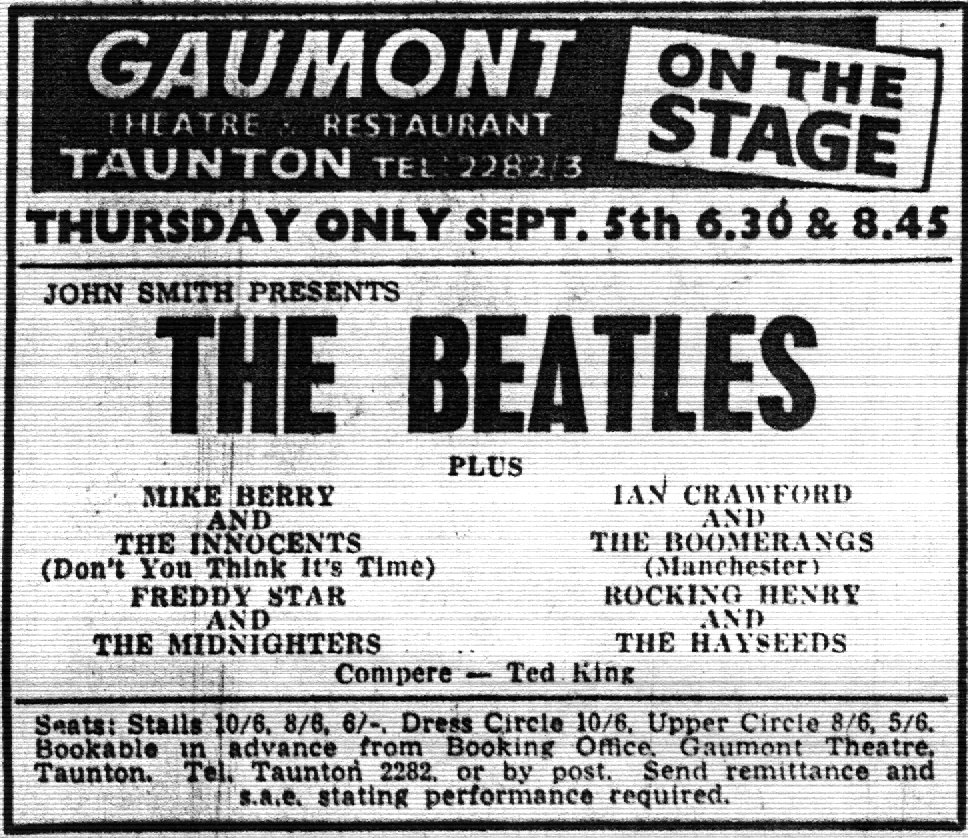
The Beatles re-appear at The Gaumont Theatre, but this time as headliners just 6 and a half months after their previous engagement. Apart from the rumour that the band appeared at the Royal Clarence Hotel (see November 1963) their two stage performances in Taunton are the closest they got to appearing in this town. (Apart from a brief appearance in a Fish N’Chip Shop in Roman Road, Taunton on the 15th September 1967 when filming “Magical Mystery Tour”) A sign of the changing times….. Above the Beatle advert in the Mercury is another Gaumont billing, a F W Entertainments Ltd production of “Snow White & The Seven Dwarfs” with 50’s singer Ruby Murray in the lead role.
9th September 1963
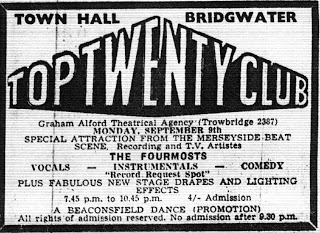
THE FOURMOST
A further indication of Merseybeat’s growing popularity and that Graham Alford had his finger firmly on the pulse. En route to conquering the world, Merseybeat hits Bridgwater! The Fourmost were formed by Brian O’Hara and Billy Fury’s pal Billy Hatton in 1958 first as “The Blue Jays” and then “The Four Jays” and were, of course, just a small part of the huge explosion of music that occurred on Merseyside during the early 60’s. The reason for this musical revolution is hard to pinpoint exactly but one initial and significant development was that skiffle went electric. Despite the record moguls in London declaring that, after Lonnie Donegan, vocalists were the future of popular music*, in a number of UK cities skiffle musicians continued to be influenced by the same musical styles that had captured their imagination in the first place – only this time they had replaced their tea-chest’s and washboards with amplified instruments whilst maintaining that classic 4-piece “band” line-up. Geographically and culturally removed from “The Big Smoke”, many cities began developing their own sound based on rhythm n’blues and rock n’roll though in Merseyside’s case there were a number of other important factors that resulted in something quite unique. Firstly, Liverpudlians were fairly poor by comparison with a high unemployment rate which meant that many teenagers turned to music as a way of escaping the doldrums of every day life. By 1961 there were 350 groups working in the Merseyside area alone. Hardly surprising that under these circumstances, a Liverpool scene should emerge. Secondly it was a more cosmopolitan city than most with a mix of races and a healthy exchange of cultures, a situation that was accentuated by it’s close proximity to the River Mersey. Finally, the fact that Liverpool was a sea port was of paramount importance as sailors passing back and forth on a regular basis from the USA introduced into this country a selection of vinyl records from across the Atlantic that were simply not available anywhere else in the UK. These records became the staple diet of scores of young scousers playing music in the city and explains Merseybeat’s affinity with Black American soul and R&B. There may well be an element of truth to the suggestion that Liverpool simply happened to be in the right place at the right time, but it was certainly more complicated than that. The Four Jays made their debut at The Cavern Club on March 1st 1961, 3 weeks before The Beatles and after a couple of personnel changes and a new name, The Four Most’s joined the Brian Epstein revolution and almost instantly became one of a number of his bands that benefitted from sharing a management contract with The Fab Four. They were given a couple of Lennon & McCartney “cast-offs” for their first two single releases with their debut, “Hello Little Girl” supposedly written by John Lennon whilst sitting on the toilet.
This song was part of The Beatles early repertoire and was also performed during their famously unsuccessful audition for Decca Records (see story below). Given initially to Gerry & The Pacemakers, The Fourmost’s version (Epstein had shortened their name upon signing them to his roster) reached No.9 in the charts and is ultimately superior to the Fabs rather nervy and unpolished effort. The follow-up, Lennon’s “I’m In Love”, established the Fourmost still further but despite being a better tune than it’s predecessor, only reached No.17 in December 1963. Further opportunities to record Lennon/McCartney material were denied and, hardly surprisingly, the hits dried up but not before they had reclaimed their Top 10 status with their third 45, “A Little Lovin'” in April 1964. They were a band who never strayed too far from the “pop” market and whose strength was their three-part harmony, but after achieving a 100% record of successive Top 20 hits The Fourmost could not maintain this winning run and soon became the victim of diminishing returns. 1964’s “How Can I Tell Her” was a “nearly” hit as were two 1965 cover versions. The first was a pretty decent stab at The Four Tops “Baby I Need Your Loving” whilst the second was an unforgivably naff take on The Coasters “Girls Girls Girls” that included an excruciating Bugs Bunny vocal to accentuate the comedic aspect of the song. Despite the erratic nature of these releases, the singles at least suggested that the band’s shelf life might be extended for a little longer but they never troubled the Top 40 again. 1965 saw them enjoy a brief appearance in the film “Ferry Cross The Mersey” plus the release of their one and only album, the cunningly titled “First And Fourmost”. It featured a ragbag of cover versions and one or two further efforts at “tickling the funny bone” that, whilst pointing the way ahead to a career beyond beat music, failed miserably. 1966 saw the death of original member Mike Millward from leukaemia and when the release of another Beatle tune, McCartney’s gorgeous “Here There & Everywhere”, failed to make an impression, their days as a viable pop group were well & truly numbered. At this point in musical history the times were indeed a changin’ with many bands from the early 60’s keen to re-invent themselves as faux flower children. But it rained heavily throughout The Fourmost’s summer of love as they spent a small part of it attempting to put George Formby back in the charts by releasing his “Auntie Maggie’s Remedy” as a single. Complete with spoons and toy whistles, it, unsurprisingly, failed to capture the spirit of the times and not long after their penultimate 45, 1968’s “Rosetta” (which featured a certain Mr.McCartney on piano) the band, now called Format, ceased recording altogether and headed directly for the comparative comfort of the cabaret circuit. “Hello Little Girl” was released in the very same month that the band appeared at The Town Hall though it turns out this was not a coincidence. At this point it becomes apparent that the idea behind the Top Twenty’s new policy of booking bands was to capture these artists as they were setting out on their debut tour of the UK and that certainly seems to be the case here.
*Dick Rowe, the A&R man at Decca Records, turned down The Beatles after their audition with the company. Rowe famously suggested to the group’s manager : “Groups with guitars are on their way out Mr.Epstein. You really should stick to selling records in Liverpool”
The Fourmost at the tailors (Pathe News reel – 1964)
16th September 1963
Colin & Bruce with The Detours (“with Fabulous New Drapes & Lighting Effects!”)
23rd September 1963
Johnny Milton & The Condors
For the first time with this advert, The Top Twenty also announced forthcoming attractions, one of which was a return visit by The Barron Knights. The Knights DID return to The Town Hall but not until May 1964 which either suggests that bookings were being made well in advance or that this proposed concert never took place.
30th September 1963
The Fabulous Tuxedoes with Bobby Angelo & Susan Terry
21st October 1963
WAYNE FONTANA & THE MINDBENDERS
The Northern music scene in 1963 was in such rude health that Manchester boasted almost as many bands as their near-neighbours Liverpool. This sometimes made it hard to distinguish as to which of these two cities some groups actually came from. Wayne Fontana & The Mindbenders were Mancunian and made their Town Hall debut during the year of the band’s birth. Glyn Geoffrey Ellis was an ex-apprentice telephone engineer who re-named himself after Elvis Presley’s drummer D J Fontana (and not the record label as has been suggested.) He formed The Jets, a semi-professional band that were a regular group on the local Manchester circuit between 1961/62. Legend has it that when, ironically enough, Fontana Records expressed an interest in signing The Jets an audition was arranged at the Oasis club in the city centre. Unfortunately, only Fontana and bassist Bob Lang turned up so two other local musicians who just happened to be drinking in the venue’s coffee bar were cajoled into making up the numbers. Of the two, 18 year-old guitarist Eric Stewart was already an old hand having played with both Gerry Lee & The Stagger Lees and another band called The Jets, this one fronted by the singer Johnny Peters. Stewart was still with Peters at the time but with Fontana (the label) offering Fontana (the singer) a contract despite an indifferent Oasis performance, Stewart quickly jumped ship whilst handing in his notice at the local drawing office. Renaming themselves after Dirk Bogart’s just released movie The Mindbenders, (a film about sensory deprivation experiments), the quartet’s first release was a cover of Fats Domino’s “Hello Josephine” but it barely made the Top 50, peaking at number 46 in June 1963. Two further singles, “For You, For You” and a cover of The Diamonds “Little Darling'” were even less successful, but the label stuck with the band and after their version of Ben E. King’s “Stop Look and Listen” made number 37 in May 1964, their breakthrough arrived in November of that year when Curtis Mayfield’s “Um Um Um Um Um”, originally recorded by the obscure American soul singer Major Lance, reached No.5. The band enjoyed an even bigger hit in February 1965 when Clint Ballard’s “The Game of Love,” reached No.2 in Britain and achieved the rare distinction of going to No.1 in the American Billboard Hot 100 but just as world domination beckoned, disaster struck. A tour of the States was planned to capitalise on their Billboard success but despite completing a promotional visit, the band were refused visas by officials concerned about the flood of British groups working in American venues whilst denying their USA counterparts the opportunity to play instead. Immigration officials demanded statements from both Billboard and Cashbox to prove that the band’s Stateside success justified their presence on American soil. Somehow the band survived this fiasco, but their situation was not helped when they turned down Hank Ballard Jnr’s “I’m Alive” as a follow-up to “Game Of Love” allowing The 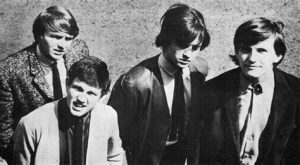 Hollies to take the song to the No.1 spot. The writing was on the wall – at least for The Mindbenders – as Wayne Fontana had long harboured ambitions to make it as a solo singer. The group continued to achieve chart success, albeit on a minor scale, but with Fontana’s management company also convinced that Wayne would be better served without his band, the decision was made for him to leave. Unfortunately, no-one told the group of these plans and in October 1965, Fontana walked off stage midway through a live show leaving Stewart and the boys to carry on without him. The group continued as a three-piece, which was apparently what the label and management company had been planning all along but the move was only marginally successful and was soured by band and singer continuously slagging each other off within the pages of the music press. Fontana’s early solo singles continued with the soulful direction that had yielded positive results with The Mindbenders. His debut, a version of Garnet Mimms “It Was Easier To Hurt Her” was surprisingly good whilst the equally worthy follow-up, Jackie Edwards “Come On Home” reached No.16. But Fontana’s biggest hit was ironically written by future Mindbender Graham Gouldman, his somewhat syrupy “Pamela, Pamela” reaching No.11 in December of 1966. But his career struggled to maintain momentum and from 1967 onwards he was filed under “missing persons” chart-wise. The Mindbenders, now with Eric Stewart at the helm, initially threatened to upstage their ex-vocalist when their first release, the superior “Groovy Kind Of Love” reached No.2 in December 1965. But despite several more single releases, The Mindbenders eventually disbanded in 1969.
Hollies to take the song to the No.1 spot. The writing was on the wall – at least for The Mindbenders – as Wayne Fontana had long harboured ambitions to make it as a solo singer. The group continued to achieve chart success, albeit on a minor scale, but with Fontana’s management company also convinced that Wayne would be better served without his band, the decision was made for him to leave. Unfortunately, no-one told the group of these plans and in October 1965, Fontana walked off stage midway through a live show leaving Stewart and the boys to carry on without him. The group continued as a three-piece, which was apparently what the label and management company had been planning all along but the move was only marginally successful and was soured by band and singer continuously slagging each other off within the pages of the music press. Fontana’s early solo singles continued with the soulful direction that had yielded positive results with The Mindbenders. His debut, a version of Garnet Mimms “It Was Easier To Hurt Her” was surprisingly good whilst the equally worthy follow-up, Jackie Edwards “Come On Home” reached No.16. But Fontana’s biggest hit was ironically written by future Mindbender Graham Gouldman, his somewhat syrupy “Pamela, Pamela” reaching No.11 in December of 1966. But his career struggled to maintain momentum and from 1967 onwards he was filed under “missing persons” chart-wise. The Mindbenders, now with Eric Stewart at the helm, initially threatened to upstage their ex-vocalist when their first release, the superior “Groovy Kind Of Love” reached No.2 in December 1965. But despite several more single releases, The Mindbenders eventually disbanded in 1969.
After the end of the swinging 60’s, the fortunes of the two main protagonists of this band could not have been any more different. Eric Stewart became an original member of 10cc during the early 70’s and co-wrote some of their biggest hits including “I’m Mandy Fly Me” and the No.1’s “I’m Not In Love” and “Dreadlock Holiday”. He also spent a period during the 1980’s as Paul McCartney’s co-songwriter. As for Fontana, like a lot of singers with the inability to maintain a steady level of artistic output, he was well on the way to cabaret and those endless “Sounds of The 60’s” package tours. In fact the only headline that Fontana has achieved since 1966 was a particularly embarrassing one. “In 2005, he fought off bankruptcy, but was arrested after police were called by bailiffs who went to his home in Glossop, Derbyshire. He poured petrol on to the bonnet of a car, and set it alight with a bailiff inside. Fontana was remanded in custody on 25th May 2007 in regard to the charge. He appeared at Derby Crown Court dressed as the lady of justice, with a sword, scales, crown, cape and dark glasses, claiming “justice is blind”. On 10 November 2007, he was sentenced to 11 months for setting fire to the car but was released. From a Bridgwater perspective, the band continued to re-appear regularly at The Top Twenty regardless of their current status, one of the very few “chart” acts to do so. They made 5 appearances in total, 4 times with Wayne Fontana and once without him. After their initial performance they returned in June 1964 then made their 3rd appearance on the 2nd November 1964 just 2 months after the release of their first Top 5 hit. “The Game Of Love” was issued during the same month as their 4th appearance in January 1965 whilst The Mindbenders solitary gig without Wayne occurred just 2 months after the release of “Groovy Kind Of Love”.
4th November 1963
TANIA DAY with The ROCKIN REBELS
Another Town Hall artist whose history remains a guarded secret amongst all and sundry apart from Ms Day and, one would imagine, various members of The Rockin Rebels. The Mercury billing stated, a little too excitedly, “Don’t miss the blond bombshell!” Well at least we know the colour of her hair.
11th November 1963
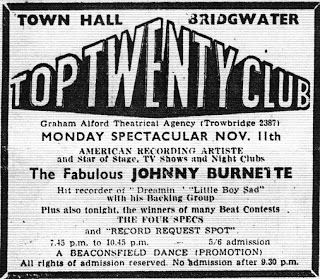
JOHNNY BURNETTE
Apart from Jerry Williams (who doesn’t really count) Burnette is the only non-UK artist to have played The Top Twenty and is most certainly the only singer to have appeared under it’s banner that hailed from the US of A. Probably most well-known for 2 sizable “teen” hits released in 1960, he was also a bona-fide rockabilly artist whose 25 recordings for the Coral label in 1956 with “The Rock N’Roll Trio” are revered amongst musicians and fans alike as some of the most compelling and powerful slabs of rockabilly ever committed to vinyl. On a more sombre note, at the time of making his Top Twenty appearance he had less than one year to live. Johnny was born in Memphis, Tennessee and along with brother Dorsey grew up in a public housing project in the Lauderdale Courts area, which, from 1948 until 1954, was also the home of Elvis Presley. As kids both he and Dorsey were keen amateur boxers and went on to become Golden Gloves Champions. After leaving high school, Johnny tried his hand at becoming a professional fighter, but after one bout in which his nose was broken he decided to quit. He and Dorsey worked on the barges that sailed down the Mississippi River, and with both showing a keen interest in music, they would work during the day and play the local bars at night with a number of like-minded musicians that included another former Golden Gloves champion, guitarist Paul Burlison. In 1952, the Burnette brothers & Burlison formed a group called The Rhythm Rangers. Having already been turned down by Sam Phillips at Sun Records due to their musical similarities with Elvis, Scotty & Bill, in 1956 a Presley appearance on the “Tommy & Jimmy Dorsey TV show” convinced them to move to New York. The trio got an audition with the Ted Mack Original Amateur Hour, an “Opportunity Knocks” type program which was broadcast on both radio and TV. They won the competition three times in a row, which gained them a place in the finals and a recording contract with Coral Records. It was at this point that they officially became known as “The Rock & Roll Trio” and it was during Burnette’s short stay with Coral that he cemented his reputation by recording the tracks that would prove to be his legacy. “There’ve been wilder, one-off examples of rockabilly but, viewed as a whole, the 25 Coral tracks remain unrivalled for unsubtle power and raw intensity” said one observer.
Promotional appearances were arranged for Dick Clark’s American Bandstand, Steve Allen’s Tonight Show and Perry Como’s Kraft Music Hall, together with a summer tour with Carl Perkins and Gene Vincent. On Sept 9th 1956, they appeared as finalists in the Ted Mack Original Amateur Hour at Madison Square Garden but were narrowly beaten for the coveted prize. Coincidentally on the same evening, Elvis made his debut Ed Sullivan appearance on CBS. Despite all of this frenetic activity, the three singles issued by the band on Coral failed to make the national charts. One of the reasons for this failure is that the music was far too raw for the general public to digest and consequently lacked commercial appeal. In fact prior to his chart success in 1960 with Liberty Records and despite regular appearances on TV, Burnette failed to have any significant hits during the late 1950’s. After an argument over billing, brother Dorsey left the group and was replaced by Johnny Black, the brother of Elvis’ bassist Bill Black, but with the group still failing to hit the big time, the trio officially disbanded in Autumn 1957. Johnny decided to try his luck in California. He and a friend, Joe Campbell, hitched down to the West Coast and after meeting up with brother Dorsey, a brief but short-lived attempt at re-uniting the The Rock N’Roll Trio ended when Paul Burlison returned home to concentrate on his electrical business. The trip however was not entirely unsuccessful as The Burnettes’ brashness got them their first major music business coup. On arriving in LA, Joe Campbell bought a copy of “A Map To The Stars”, a pamphlet which showed locations of the homes of the rich and famous. In an effort to peddle some songs to the teen idol Ricky Nelson, the boys sat on the steps of the star’s house until he turned up. Their persistence paid off as Ricky was sufficiently impressed with their material to record a number of their songs including “It’s Late”, “Waitin’ In School” and “Just A Little Too Much” amongst others. Despite Johnny & Dorsey securing a record contract with Imperial on the strength of their Nelson connection, Johnny was unable to capitalise on their songwriting success and spent the next 2 years still searching for the big breakthrough. In 1958, Johnny released 3 singles as a solo artist with Freedom Records, which was an off-shoot of Liberty. In mid-1959, after Freedom was shut down, Johnny moved to the main label under the direction of producer Tommy “Snuff” Garrett. With the bigger company carrying more promotional clout than Freedom, Johnny’s singles were advertised and distributed to a wider audience and even though his first two releases only sold well regionally, his third single, “Dreamin’” (May 1960) reached No.11 on the Billboard Hot 100 and No.5 in Britain. By comparison to the raw recordings from 1956, “Dreamin’”, complete with orchestral backing, was firmly aimed at the teen market but it was his next record that made Burnette a star. “You’re Sixteen”, released in October 1960, reached No.8 on the Hot 100 and No.3 in Britain and earned him a gold record. After trying to capitalise on his success Burnette’s career was curtailed when firstly a ruptured appendix and then exhaustion caused by attempting to return from the illness too soon meant a lack of promotion which consequently affected the chart positions of each subsequent Liberty release. After finally recovering, Johnny returned to the road with a triumphant tour of the American North, culminating in a season at the Brooklyn Paramount Theatre, after which he undertook a highly successful tour of Australia with Connie Francis. Further singles for Liberty were issued but only the firmly patriotic “God, Country and My Baby” charted, reaching #18 on the Hot 100 and this was to be Johnny Burnette’s last major hit. In 1962, Johnny toured Britain for the first time with Gary U.S.Bonds and Gene McDaniels, and appeared on the NME Poll Winners’ Concert and several TV programs.
By the time he had reached Bridgwater, Burnette had left Liberty and continued to jump from label to label. He recorded for Chancellor Records, a company that had had success with teen idols like Fabian and Frankie Avalon, briefly joined forces with Dorsey on Reprise and then signed a one year contract with Capitol in the summer of 1963. “It Isn’t There” was issued on August 19th 1963 as his first single for the label. When his Capitol contract ran out, Johnny decided to take charge of his own affairs forming his own Sahara Records (later re-named Magic Lamp). But just 6 months after his Town Hall appearance tragedy struck. After dark on August 14th 1964, Johnny’s tiny unlit fishing boat was hit by an unaware cabin cruiser on Clearlake, California. The impact threw him off the boat and sadly, Johnny drowned.
THE FOUR SPECS
Simply billed as “The winners of many beat contests”, one imagines whether they also provided backing for Burnette as the proverbial “scratch band”.
15th November 1963
A CRUSH ON THE BEATLES!
Rush hour traffic was delayed in the centre of Bridgwater on Friday evening (15th) when a rumour spread that The Beatles, a Merseyside act consisting of four young men*, were at The Royal Clarence Hotel. Hundreds of youngsters, the vast majority of them girls, rushed to the area and it took the police, led by an inspector, three hours to get the streets and pavements completely clear. One harrassed constable told a group of Bridgwater Grammar School girls, who were screaming up at one of the hotel windows, “There are no Beatles here and there are not going to be any” (* Talk about understatement!!!!)
25th November 1963
THE LONELY ONES with Gene Anthony & Johnny Keepings
This band heralded the return of the Southampton “Avenue Artists” set-up that had served The Top Twenty so well previously. Info regarding “The Lonely Ones” is scarce and is currently limited to the band’s line-up which consisted of Keeping & Anthony on vocals, Jim Sachs (bass) Tony Goode (guitar) Joey Bromley (bass) and Chris Warman (drums). It would appear that there were two distinct sides to the group’s repertoire with Anthony responsible for the ballads whilst Keeping was reserved for the more uptempo numbers. It is hardly surprising therefore that the band eventually split down the middle with Keeping, Sachs & Good fronting “The Soul Agents”, a group whose name not only betrayed their musical leanings but who also backed Rod Stewart at some point during their career.
2nd December 1963
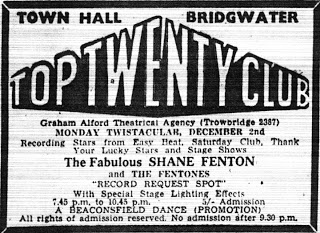
SHANE FENTON & THE FENTONES
If Johnny Burnette’s career ended in tragedy (see above) then Shane Fenton & The Fentones were a band born out of it. From Mansfield, Johnny Theakstone & The Tremoloes were formed in 1961, and after sending an audition tape to the BBC’s Saturday Club, lead singer Theakstone decided on a spot of re-invention. Depending on which story you believe, Theakstone chose “Shane” from the film of the same name or from Albert Shane who had recently co-written a Gene Vincent single, and “Fenton” from either a Mansfield garage or a local printing firm. The newly named band duly posted their tape to the Beeb and anxiously waited for a reply. Sadly within days of receiving the corporation’s thumb’s up, Theakstone was taken ill and tragically died as a consequence of the rheumatic fever that he had suffered as a kid. Unsurprisingly, the band decided to break up, but Theakstone’s mother asked them to continue in memory of her deceased son. Bernard Jewry was originally from Muswell Hill but had moved to Mansfield at the age of two, appearing in panto when he was just 4 years old. At the tender age of 17, Jewry took part in an amateur showcase held at the Mansfield Palais and it was during this performance that he befriended Theakstone, eventually taking on the “lucrative” job of becoming the Fentones roadie. Jewry occassionally sang with the band on an ad hoc basis, consequently after Theakstone’s untimely death he was given the unenviable task of stepping into the singer’s shoes by becoming the “new” Shane Fenton.
The band breezed through the BBC’s audition and under the management of Tommy Sanderson had, within a matter of months, secured a Parlophone recording contract with George Martin as their producer. After the first choice for their debut single, the novelty song “Five Feet Two, Eyes Of Blue” was jettisoned in favour of a Jerry Lordan composition, the rather jaunty “I’m A Moody Guy” reached No.21 in September 1961. There seems little doubt that Shane & The Fentones were Cliff Richard & The Shadows clones with Jewry’s high-pitched voice occupying similar territory to Richard’s wispy vocal style and in early 1962 the band joined forces with Billy Fury and The Tornadoes on a Larry Parnes package tour but subsequent single releases, including an instrumental by The Fentones, only reached the lower regions of the singles chart. Included amongst these was Fenton’s 3rd single release, “It’s All Over Now”, a song originating from 1920 which reached the heady heights of No.29, but hiding away on it’s B-side was an absolute gem, the self-penned “Rave On” inspired “Why Little Girl” which, had it been promoted as the new single, could have provided the band with their big breakthrough. June 1962 finally saw a return to the Top 20 with a cover of “Cindy’s Birthday”, originally recorded by American TV teen star Johnny Crawford but it was to be the band’s last hit and despite appearing in the Billy Fury showcase movie “Play It Cool” by early 1963 Fenton was being touted as a solo artist. The Fentones continued to back Shane on the road, but had been dispensed with as a recording band which at this point boasted the talents of future Hollies drummer Bobby Elliott. It was during this same year that Fenton chose to remain loyal to manager Sanderson by turning down the opportunity to sign for Brian Epstein which in turn lost him the chance to record Lennon/McCartney’s “Do You Want To Know A Secret?” subsequently given to Billy J Kramer. Apart from showing a lack of good judgement, their reluctance to update their sound proved costly. The Fentones parted company with Shane altogether in 1964 and apart from a brief spell as a duo with his later wife Iris Caldwell (who was incidentally Rory Storm’s sister), Jewry joined forces with ex-boss Sanderson and briefly enjoyed some success as a manager with both The Hollies & Lulu amongst his clientele. But Jewry’s story doesn’t end there. After doing the cabaret circuit to death for several years, in the early 70’s he joined forces with writer/producer Peter Shelley and re-invented himself as the black-leather-glove-wearing glam rock star Alvin “My Coo-Ca-Choo” Stardust. Alvin’s new image was not exactly original, being a well-worn mixture of both 50’s rocker Gene Vincent and 60’s vocalist Dave Berry with added fairy dust, but it worked and after several years in the wilderness it re-established Jewry as a bona-fide pop star once again with alter-ego Stardust chalking up no less than 7 Top 10 hits between 1973 and 1984. “He comes on lean and glistening, wrapped in a tight skin of reptilian black leather. He is a great panther pacing the stage with graceful majesty…” Disc Magazine 1974. You have to give it to Bernard/Shane/Alvin. Anyone who is able to maintain a career over a fairly lengthy period of time deserves credit and even though he unashamedly jumped onto the glam bandwagon, his ability to re-invent himself should be commended. He was about to make another comeback in 2014, but just weeks before the release of his first record for 30 years, Bernard sadly succumbed to prostate cancer.
16th December 1963
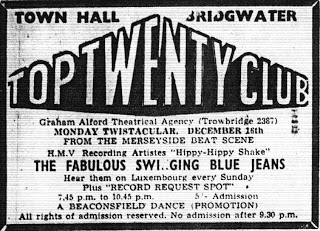
THE SWINGING BLUE JEANS
If the Fourmost were part of the 2nd wave of Merseybeat artists to have obtained success in the UK, then The Swinging Blue Jeans were at the point of it’s creation having been formed out of two skiffle groups that finished first and second respectively in a talent contest held at the Liverpool Empire in May 1958. Originally called The Bluegenes, they held residencies at a number of Liverpool venues including The Cavern Club and were top of the bill when The Beatles made their debut there on the 21st February 1961 as part of the group’s “Tuesday Guest Night” slot. The band were a regular attraction in the Liverpool area but initially appear to have been out on a limb musically in comparison to most of the other Merseyside bands that were peddling their wares during the early 60’s. Suggestions were that their sound was vaguely “jazzy” during their formative years, but despite being at the vanguard of MerseyBeat they were not fan favourites, probably becuase they didn’t sound like anybody else. The Cavern’s compere Bob Wooler suggested as such whilst writing for “Mersey Beat” magazine in October 1961. Wooler offered a list of what he considered to be the 10 most popular bands in Liverpool at the time but the line-up did not include The Bluegenes with Wooler suggesting that “They are beyond comparison. They are in a class of their own”. Whilst this may well have been the case, this did not necessarily help the band’s popularity as in January 1962, when the results of the first Mersey Beat poll appeared, the band were not even included in the Top 20. They added their “Swinging” appendage in 1963, and quite possibly along with the name change, became an archetypal beat group in the process. Despite the suggestion that they secured a recording contract largely on account of their geographical status, their debut single “It’s Too Late Now” made it into the Top 30 but the 2nd release, the nondescript “Do You Know” didn’t chart at all. Luckily fate dealt the group a couple of more than decent breaks. Firstly Lybro jeans decided to sponsor the groups own weekly “Swingtime” radio show which briefly held a 13-week residency on Radio Luxembourg and secondly a cameo appearance in the Christmas Day 1963 edition of “Z Cars” performing “Hippy Hippy Shake” heightened their national exposure and as a consequence, the single, a cover of an obscure ’50s rocker by Chan Romero, reached No.2 in January 1964. 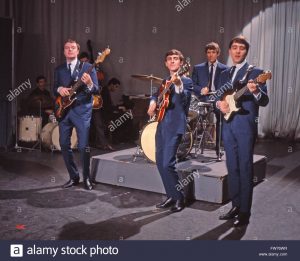 This song was part of The Beatles repertoire during the early 60’s and the story goes that The Blue Jeans first heard it performed by The Fab Four during one of their guest appearances at The Cavern and duly nicked it, recording their own version just one week later.* For their second 45, the band effectively repeated the winning formula of their previous release by producing a fine version of Little Richard’s “Good Golly Miss Molly” which reached No.11 just 2 months after their debut but their finest hour was undoubtedly their cover of Betty Everett’s “You’re No Good,” which they took to No.3 in July 1964 and which remains arguably one of the finest examples of Merseybeat ever committed to vinyl. But after this success The Blue Jeans struggled to maintain their status, a situation not helped by the fact that they apparently once turned down an appearance on the Ed Sullivan Show in order to honour a prior engagement in Sweden. The mediocre material they recorded throughout the mid-60’s did not help matters, consequently when founder member Ralph Ellis left in 1965 they very quickly found themselves out in the cold. Ellis was replaced by ex-Escorts vocalist Terry Sylvester and 1966’s half decent cover of Bacharach/David’s “Don’t Make Me Over” succeeded in achieving a No.31 chart placing despite receiving a scathing review in the music press by no less an individual than Paul Jones of Manfred Mann. But by the following year, their swing had very much been swung and attempts to address their decline resulted in changing their name to Music Motor for a brief period, whilst further releases during both 1967 & 1968 appeared under both The Bluejeans and Ray Ennis & The Bluejeans. All to no avail. Sylvester chose the inevitable escape route by replacing Graham Nash in The Hollies and the band finally folded. There have been several attempts at comebacks however – single releases for the Dart label in 1973 and the EMI & Rio labels in 1989 (which included a re-make of their first single). Consequently the band, under the careful guidance of Ray Ennis, continued, still swinging, forever blue jeaned.
This song was part of The Beatles repertoire during the early 60’s and the story goes that The Blue Jeans first heard it performed by The Fab Four during one of their guest appearances at The Cavern and duly nicked it, recording their own version just one week later.* For their second 45, the band effectively repeated the winning formula of their previous release by producing a fine version of Little Richard’s “Good Golly Miss Molly” which reached No.11 just 2 months after their debut but their finest hour was undoubtedly their cover of Betty Everett’s “You’re No Good,” which they took to No.3 in July 1964 and which remains arguably one of the finest examples of Merseybeat ever committed to vinyl. But after this success The Blue Jeans struggled to maintain their status, a situation not helped by the fact that they apparently once turned down an appearance on the Ed Sullivan Show in order to honour a prior engagement in Sweden. The mediocre material they recorded throughout the mid-60’s did not help matters, consequently when founder member Ralph Ellis left in 1965 they very quickly found themselves out in the cold. Ellis was replaced by ex-Escorts vocalist Terry Sylvester and 1966’s half decent cover of Bacharach/David’s “Don’t Make Me Over” succeeded in achieving a No.31 chart placing despite receiving a scathing review in the music press by no less an individual than Paul Jones of Manfred Mann. But by the following year, their swing had very much been swung and attempts to address their decline resulted in changing their name to Music Motor for a brief period, whilst further releases during both 1967 & 1968 appeared under both The Bluejeans and Ray Ennis & The Bluejeans. All to no avail. Sylvester chose the inevitable escape route by replacing Graham Nash in The Hollies and the band finally folded. There have been several attempts at comebacks however – single releases for the Dart label in 1973 and the EMI & Rio labels in 1989 (which included a re-make of their first single). Consequently the band, under the careful guidance of Ray Ennis, continued, still swinging, forever blue jeaned.
*It has also been suggested that actress Sue Johnston, of “Brookside” and “Royle Family” fame had to buy the original version of “Hippy Hippy Shake” in Brian Epstein’s NEMS record store so that lead singer Ray Ennis could learn the lyrics!
23rd December 1963
Johnny Carr & The Cadillacs
30th December 1963
Peter Jay & The Jaywalkers
ADDENDUM
DAVE DEE & THE BOSTONS
We know that Dave and his chums Dozy, Beaky, Mick & Tich played Bridgwater on at least two occasions during 1966 but what about Dave’s previous incarnation as leader of the mysterious “Bostons”? Whilst there may be no local adverts proclaiming that they ever set foot in our town, according to Mike Guy, the trustworthy “Bridgwater Mercury” reporter and Top Twenty devotee, “It was as Dave Dee and The Bostons that the group first appeared at the Top 20 Club more than two years ago”. Mike wrote this after DDDBM&T’s triumphant debut appearance in Bridgwater in February 1966 and even though Mike could have been referring to a performance from another venue, it does suggest that Dave had been here before. Dave Dee & The Bostons made their debut at the Trowbridge Town Hall on April 26th 1963 and returned 6 months later. Chances are that he squeezed in a Bridgwater gig during this period as well.


Comments